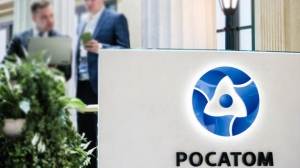Rosatom names key avenues of cooperation with Belarus

We are witnessing a rapid advancement of nuclear technologies around the world. They are used in medicine, agriculture, manufacturing and transport. The Russian state nuclear industry corporation Rosatom is a leader in this area. Director of OOO Rusatom Bel (Rosatom's country office in Belarus) Stanislav Levitsky spoke about the collaboration between Belarus and Russia in nuclear technology projects.
Nuclear medicine
The first medical brachytherapy devices Agat were developed back in the 1980s. Brachytherapy is a type of internal radiation therapy that is used to treat cancer. Rosatom has rolled out the Brachium complex that is based on Agat. “The concept of the brachytherapy complex has not changed dramatically here or abroad. The planning system, applicator technologies, and isotopes that are used by the device have changed. Yet, this complex is a very advanced version of the good old device,” said Stanislav Levitsky.
A cooperation agreement was signed between Rusatom Healthcare (the Rosatom division that accumulates expertise in the field of healthcare) and Belarus' Medtechnocenter on the sidelines of the international forum Atomexpo in Sochi. The document formalized plans to supply medical equipment manufactured in the Russian Federation. “There are plans to implement two or three Union State programs. One of them provides for the development of medical devices like, for example, Brachium 2.0. It will incorporate an ultrasound device and will have an improved planning system. This equipment will fully meet the needs of the Russian Federation, Belarus and third countries,” Stanislav Levitsky said.

In addition, the head of the country office noted that Russia is ready to supply cancer treatment devices to Belarus. “As far as I know, this year Belarus plans to replace several devices. We are ready to participate in a tender. If we know how many brachytherapy devices will be needed in the next three or four years at the minimum, we will be able to make a comprehensive offer. In this case the Healthcare Ministry will be able to purchase these devices,” he said.
According to Stanislav Levitsky, last week a Rosatom delegation visited two cancer centers and presented the Brachium complex.
Another solution is the Onyx radiation therapy complex based on a compact medical linear accelerator. It has already been registered in the Russian Federation. “Now it is being installed in several cancer centers of the Russian Federation. It is a promising development that we want to put to the test. When trials are over, we will introduce this product more widely,” the director explained.
In addition to that, the state corporation Rosatom has embarked on the construction of a plant in Kaluga Oblast that will produce radiopharmaceuticals. The construction works are to be completed in 2025. “This will be the biggest radiopharmaceuticals manufacturer in entire Europe, or maybe even in Eurasia,” Stanislav Levitsky assured.
Nuclear research reactor
The National Academy of Sciences of Belarus and the state corporation Rosatom continue to discuss the construction of a nuclear research reactor on the premises of the Joint Institute for Power and Nuclear Research Sosny. “I have recently visited this institute, and we had a very good and productive conversation with the director. We are reconciling our positions on an intergovernmental agreement. Once the document is finalized, we will proceed to the construction of the reactor. We are ready for it. The interaction format can vary, this can be a joint venture, for example. Coordination is a long and complicated process. The interests of the Belarusian and Russian sides will definitely be taken into account, legislative norms will be harmonized. I hope that by the end of this year we will come to terms and will be able to get down to construction. We view this reactor as an excellent opportunity to maintain the nuclear safety of the Belarusian nuclear power plant, test new fuel assemblies and to see whether the production of isotopes makes economic sense,” said Stanislav Levitsky.
When asked how long it will take to build the reactor, he assured that this can be done quickly and efficiently, just like the construction of the BelNPP. “Although a research reactor is a technologically complex project, it does not require as much work and funding. I think that it is quite realistic to build it within two to three years from the date of signing of binding documents,” he explained.
Radioactive waste management
“A radioactive waste management concept has been developed. It provides for building a complex to process radioactive waste in Belarus by 2030. As far as the BelNPP is concerned, this means that we will take in fuel, process it in Russia and send it back for storage in accordance with international standards,” said Stanislav Levitsky.
Rosatom is also actively promoting its REMIX fuel concept. It can ensure a 10-time reduction in the amount of high-level waste. It also cuts costs for the construction of storage and processing facilities. “In general, we have a wealth of experience in the construction and operation of storage facilities. We provide guidance and organizational support,” the specialist added.
Sterilization of foodstuffs
Irradiation of food products is one of food preservation techniques. However, unlike canning, it does not use chemicals. Irradiation deactivates chemicals and pesticides, extending the shelf life of food. According to the IAEA, sterilization of food products using ionizing radiation is a reliable and safe way to treat food and agricultural products.
The Russian Federation has 12 multifunctional processing centers. This technique has been used for more than 30 years.

As for Belarus, Rosatom works with large agricultural enterprises and pharmaceutical companies. “Now we are assessing the total amount of products that need sterilization. This technique can be applied to agricultural products and medical products, for example, capsules for packaging medicines, gauze masks. Negotiations are underway, we are assessing the demand. Rosatom is ready to offer turnkey solutions and act as a partner,” Stanislav Levitsky added.
Energy storage systems
Rosatom is developing storage systems for the manufacturing industry, transportation sector and communications, as well as traction batteries for electric vehicles and a network of charging stations. Belarus is actively involved in each of these projects.
According to Stanislav Levitsky, OOO Renera (part of Rosatom's TVEL Fuel Company) and one of Belarusian energy companies are discussing the possibility to develop a common lineup of lithium battery storage systems. “We are actively trying to engage Belarusian National Technical University and Belarusian State Technological University in this work. The thing is that at first we should align the regulatory, methodological and organizational aspects of energy storage systems and their use in Belarus and Russia, to develop joint guidelines for substantiating the economic efficiency of the systems. A large number of storage devices makes the power grid more balanced. This will benefit power engineers, manufacturers, and ordinary consumers,” Stanislav Levitsky noted.
As far as charging stations are concerned, next week there will be an introductory videoconference by representatives of the Belarusian state petrochemical concern Belneftekhim, the Rosatom country office in Belarus, OOO Renera and the Rosenergoatom concern. “Belneftekhim has made significant advancement as far as charging stations are concerned. We want to build a better understanding of what they have done. If these are great turnkey solutions, then why should we create competing products. I really hope that we will be able to agree on these stations by the end of the year and proceed to the creation of a common lineup,” he said.
Rosatom is also working on a draft document on strategic partnership with Belkommunmash. “We exchanged views and shared our vision of cooperation. This pertains to the sale of a joint lineup of traction batteries, as well as software development. We are also considering partner programs with MAZ. Electric transport is a trending topic now, because it saves resources. Large-scale production of electric vehicles will be more cost-efficient and cheaper. In addition, we should have a closer look at the concept for swappable car batteries that are gaining ground in China. This concept may be interesting. Battery swapping allows drivers to replace depleted packs quickly with fully charged ones. In this case they do not really need charging stations,” added Stanislav Levitsky.













